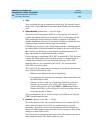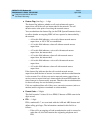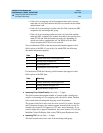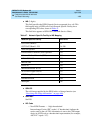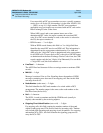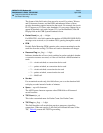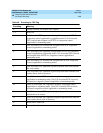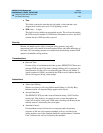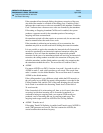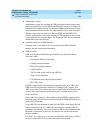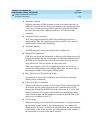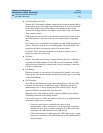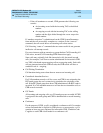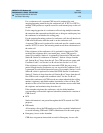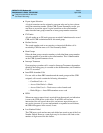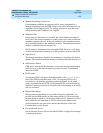
DEFINITY ECS Release 8.2
Administrator’s Guide
555-233-506
Issue 1
April 2000
Features and technical reference
1268Call Detail Recording
20
If the attendant allows through dialing, the primary extension of the user
who dialed the number is recorded as the calling party. Condition Code 1
indicates that a trunk access code was extended by the attendant. Condition
Code 7 indicates that a feature access code was extended by the attendant.
If Incoming or Outgoing Attendant Call Record is enabled, the system
produces a separate record for the attendant portion of incoming or
outgoing calls that are transferred.
On attendant-assisted calls that require an account code, the account code
must be entered before the trunk access code.
If the attendant is redirecting an incoming call to an extension, the
attendant may dial an account code before dialing the extension number.
It is not possible to option the attendant for intraswitch calls. Intraswitch
records are produced for an intraswitch-optioned extension calling the
attendant or for a call from the attendant to an intraswitch-optioned
extension. In the case of an attendant-assisted call involving an intraswitch
extension, the calling number recorded is the extension of the party who
called the attendant, and the dialed number recorded is the extension that
the attendant extended the call to. The record has a Condition Code 0.
■ AUDIX
For remote AUDIX over DCS, if station A on node 1 forwards its calls to
AUDIX on node 2, each switch produces a call record. The record from
node 1 contains A as the dialed number. The record from node 2 contains
AUDIX as the dialed number.
If the calling number is on a different switch within the DCS network, or
the call comes in over ISDN, the actual calling number is recorded in the
Calling Number field, and the TAC of the trunk bringing the call into the
local switch is recorded in the Incoming Trunk Access Code field of
24-word records.
If the forwarded call is an incoming call, then, as in all cases (other than
vectoring) in which an incoming call is forwarded, transferred, or
conferenced using an outgoing trunk, two separate CDR records are
produced, one for incoming and one for outgoing trunk usage. The
outgoing trunk usage record lists AUDIX as the Calling Number.
■ AUDIX - Transfer out of
If Incoming Trunk Call Splitting is enabled, and Transfer out of AUDIX is
used, CDR generates two records. The first contains the AUDIX, the
second contains the transferred-to party.



